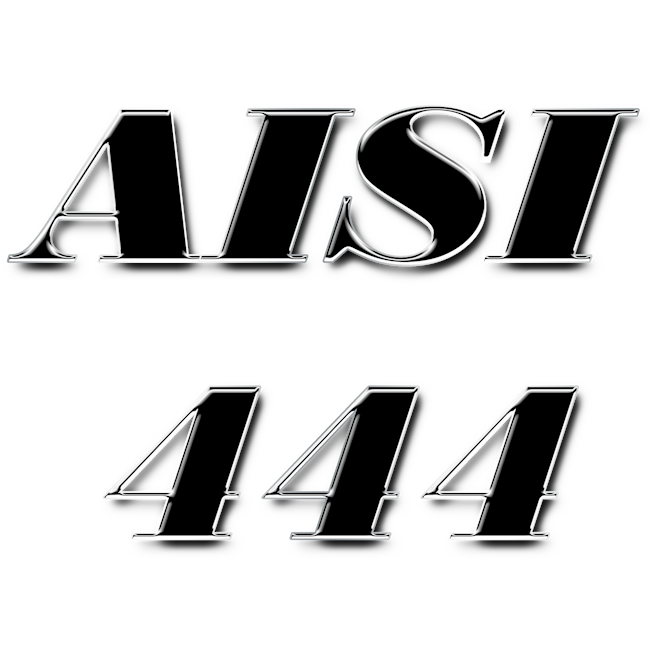AISI 444 | EN 1.4521 | DIN X2CrMoTi18-2 - is a low-carbon, molybdenum, titanium ferritic stainless steel. It has better corrosion resistance than conventional ferritic and austenitic stainless steels. It has good hardness properties and also has good resistance to sensitization during welding.
AISI 444 has very good corrosion resistance in many halogen-free organic and inorganic solutions over a wide range of temperatures and concentrations.
Withstands many diluted organic and mineral acids depending on the temperature and concentration of the solution. May have uniform corrosion in strong organic and mineral acids, as well as in concentrated hot alkaline solutions.
In aqueous solutions containing halides, such as chlorides or bromides, pitting and crevice corrosion may occur depending on the halide concentration, temperature, pH value, concentration of oxidising compounds and crevice geometry, if applicable. The presence of corrosion inhibiting or accelerating compounds, such as transition metal ions or organic compounds, may influence the corrosion behaviour of the steel. Due to its ferritic crystal structure, EN 1.4521 is not susceptible to chloride-induced stress corrosion cracking.
DIN X2CrMoTi18-2 can be used for interior and exterior construction in rural areas and urban environments where chloride pollution is low. Better performance is usually achieved through adequate design, proper post-weld treatment and regular cleaning during use.
Due to the titanium content in this grade, the risk of sensitization to intergranular corrosion is greatly reduced compared to non-stabilized ferritic grades. AISI 444 can be used in the temperature range in which chromium carbides precipitate in non-stabilized ferritic grades. The maximum operating temperature in dry air is 850 °C. The presence of other corrosive compounds in a hot environment, such as water or sulfur, can significantly reduce the maximum service temperature.
Physical properties
| Temperature | +20°С | +100°С | +200°C | +300°С | +400°С | +500°С |
| Modulus of elasticity, GPa | 220 | 215 | 210 | 205 | 195 | - |
| Coefficient of linear expansion, 10-6/°C | 10,4 | 10,4 | 10,8 | 11,2 | 11,6 | 11,9 |
| Thermal conductivity at +20°C, W/m*K | Specific heat capacity at +20°C, J/kg*K | Specific electrical resistance at +20°C, μOhm*m | Magnetic properties |
| 23 | 430 | 0,8 | magnetic |
Mechanical properties
| Tensile strength Rm ≥ N/mm² | 450 - 650 |
| Yield strength Rp ≥ N/mm² | 320 |
| Relative elongation A5 ≥ % | 20 |
| Hardness HB | 200 |
| Modulus of elasticity kN/mm² | 220 |
Technological properties
⓵ Welding
AISI 444 | EN 1.4521 has good weldability and can be welded using conventional welding methods and techniques: MMA, MIG, MAG, TIG, SAW, LBW or RSW, except gas welding.
Low interstitial levels and added stabilizer significantly improve welding characteristics. Heat input should be minimized to reduce grain growth. Double stabilization (Ti+Nb) of AISI 444 improves autogenous welds by improving the grain structure in the weld metal. Stabilization prevents chromium carbide precipitation, which could otherwise lead to sensitization embrittlement. Consequently, stabilized grades are practically not protected against intergranular corrosion under welding conditions.
Shielding gases should be Ar / He based, mixed with a maximum of 2% oxygen to improve arc stability. Hydrogen and nitrogen must not be added.
⓶ Formability
This steel can be formed using typical forming processes such as bending, flexing and drawing. It has a higher minimum strength than standard austenitic stainless steel such as AISI 304, combined with lower working hardening. Due to stabilization, the R value is higher compared to non-stabilized ferritic stainless steels. These characteristics mean excellent deep drawing ability.
⓷ Processing
It is relatively easy to machine. Compared to austenitic grades, it has a lower tendency to form edges, which gives a larger finishing window. Since machinability is comparable to that of low-alloy carbon steels, the same recommendations for tool selection, cutting speed and cutting band feed apply.
Chemical composition of steel grade AISI 444 | EN 1.4521 | DIN X2CrMoTi18-2 | |||||||||
| C | Si | Mn | P | S | Cr | Mo | N | Ti | Fe |
| <0,025 | <1,00 | <1,00 | <0,040 | <0,015 | 17,0-20,0 | 1,80-2,50 | <0,030 | <0,80 | Other |
